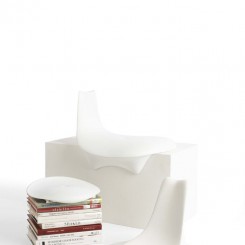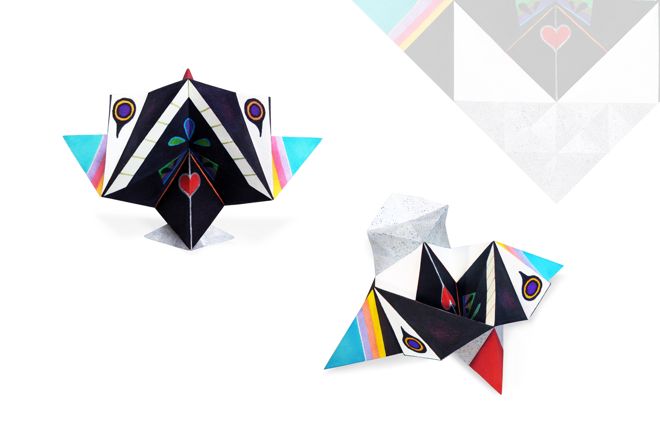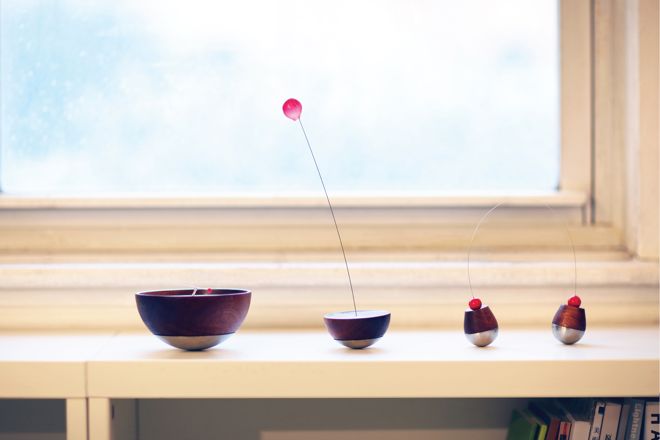Unlike the majority of young designers whose Eastern and Western aesthetic is very superficial, the very core of I Chao’s design theory stems from a deliberate intertwining of a western academic design education and deep study of Zen philosophy. His design forms feature Western lines and shapes, but at the same, they sprout from very Chinese origins, such as origami and the circus.
His products parallel the gradual globalization of the two worlds, but serve the same purpose in both worlds—to lift adults out the mundaneness of their day-to-day office jobs, and inspire creativity through these whimsical toys.
Randian: How did you move from illustration to design? Why did you decide to make that move? What is the most difficult part of the transition?
I Chao: I moved from illustration to design because I’ve always had a desire to make things. I have been painting for a long time, so naturally making sculptures was something I wanted to explore. The primary source of inspiration for my most recent project comes from a toy class I attended while studying at the Fashion Institute of Technology in New York. The playful dimensions of the toys amazed me and it drew me into the world of design.
I think the most difficult part of the transition between illustration and design was to understand the fundamental differences the two art practices. Unlike illustration, the purpose of design is not about personal expression but rather it involves a process of problem solving. I discovered that the purpose of is design products to meet peoples’ needs, and it took me sometime to explore what problems I could solve as a designer with my illustration and fine arts background. Ultimately, I found a way to engage storytelling in design by adding functional elements to my work.
Randian: Can you speak a little bit more about being a Chinese artist/designer in NYC? How do you think the art/design worlds compare?
IC: As a Chinese illustrator and designer, I truly appreciate the vibrant energy in New York City. Here I am able to attend many great art exhibitions that I could only read about while growing up in Taiwan. Living in New York gives designers and artists an advantage with its everyday inspirations and bustling art community.
There is no shortage of design knowledge in Taiwan, however I feel that my island home has a significant lack of educational resources and opportunities when compared with NYC. In New York, you can conveniently broaden your artistic visions by visiting the gorgeous collections at the Met or the MOMA, or by touring the many other art institutions offered by the city. I think it is invaluable for artists and designers to physically experience these artworks in person rather than by way of reading a textbook or on computer screen. One needs to both see and feel these works as a whole, and being in NYC is perfect for that.
Taiwan and New York have completely different art and design systems due to differences in cultural and historical backgrounds. Taiwan imports a plethora of influences from China and Japan, so quite often, Chinese traditional culture and Japanese subculture are the dominant inspiration for Taiwanese artists/designers. In general, because of these foreign influences, art and design in my home country has little variety, and lamentably it has become quite conservative.
New York on the other hand is more liberal in art and design. People here are more open-minded and they embrace things simply because they like it. There is little cultural attachment when valuing artwork as the city is full of people from diverse backgrounds. They all bring different values and perspectives to the art community here, which helps create dynamic conversations full of fresh ideas. Crazy things can happen in New York, and that art and design community here definitely reflects that.
Randian: What are your three greatest inspirations?
IC: The great Japanese animator Hayao Miyazaki, whose animations have accompanied me throughout my childhood, inspired my imagination in creating whimsical characters and stories.
The work by great American sculptor Alexander Calder has been permanently etched in my mind. His works motivate me to use spirited qualities in my sculptures. My design, The Red Nose Circus, also carries inspiration from his own circus project.
Isamu Noguchi, the great Japanese American sculptor and architect, inspired me with the Eastern spirits and tranquility featured in his sculptures. These influences lead me to research the beauty of simplicity and emptiness in Zen aesthetics.
Lastly, I am happily obliged to include the story of The Little Prince, which inspired me to explore the profoundness of abstraction.




